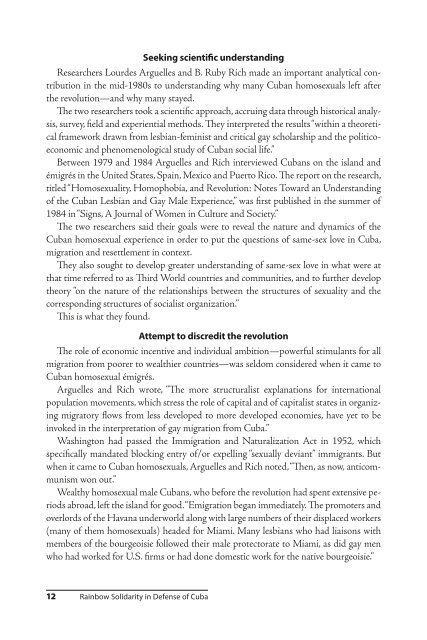LavenderRed_Cubabook
LavenderRed_Cubabook
LavenderRed_Cubabook
Create successful ePaper yourself
Turn your PDF publications into a flip-book with our unique Google optimized e-Paper software.
Seeking scientific understanding<br />
Researchers Lourdes Arguelles and B. Ruby Rich made an important analytical contribution<br />
in the mid-1980s to understanding why many Cuban homosexuals left after<br />
the revolution—and why many stayed.<br />
The two researchers took a scientific approach, accruing data through historical analysis,<br />
survey, field and experiential methods. They interpreted the results “within a theoretical<br />
framework drawn from lesbian-feminist and critical gay scholarship and the politicoeconomic<br />
and phenomenological study of Cuban social life.”<br />
Between 1979 and 1984 Arguelles and Rich interviewed Cubans on the island and<br />
émigrés in the United States, Spain, Mexico and Puerto Rico. The report on the research,<br />
titled “Homos exuality, Homophobia, and Revolution: Notes Toward an Under standing<br />
of the Cuban Lesbian and Gay Male Experience,” was first published in the summer of<br />
1984 in “Signs, A Journal of Women in Culture and Society.”<br />
The two researchers said their goals were to reveal the nature and dynamics of the<br />
Cuban homosexual experience in order to put the questions of same-sex love in Cuba,<br />
migration and resettlement in context.<br />
They also sought to develop greater understanding of same-sex love in what were at<br />
that time referred to as Third World countries and communities, and to further develop<br />
theory “on the nature of the relationships between the structures of sexuality and the<br />
corresponding structures of socialist organization.”<br />
This is what they found.<br />
Attempt to discredit the revolution<br />
The role of economic incentive and individual ambition—powerful stimulants for all<br />
migration from poorer to wealthier countries—was seldom considered when it came to<br />
Cuban homosexual émigrés.<br />
Arguelles and Rich wrote, “The more structuralist explanations for international<br />
population movements, which stress the role of capital and of capitalist states in organizing<br />
migratory flows from less developed to more developed economies, have yet to be<br />
invoked in the interpretation of gay migration from Cuba.”<br />
Washington had passed the Immigration and Naturalization Act in 1952, which<br />
specifically mandated blocking entry of/or expelling “sexually deviant” immigrants. But<br />
when it came to Cuban homosexuals, Arguelles and Rich noted, “Then, as now, anticommunism<br />
won out.”<br />
Wealthy homosexual male Cubans, who before the revolution had spent extensive periods<br />
abroad, left the island for good. “Emigration began immediately. The promoters and<br />
overlords of the Havana underworld along with large numbers of their displaced workers<br />
(many of them homosexuals) headed for Miami. Many lesbians who had liaisons with<br />
members of the bourgeoisie followed their male protectorate to Miami, as did gay men<br />
who had worked for U.S. firms or had done domestic work for the native bourgeoisie.”<br />
12 Rainbow Solidarity in Defense of Cuba


